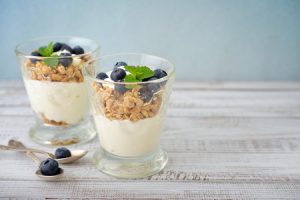
Overview
Probiotics are globally important. They are probably the archetypal functional food/ What’s more, they have a number of beneficial effects on human health. This might be reducing the incidence of cancer to minimising the effects of diarrhea, to stimulating epithelial cells and improving immunity.
Definitions
The definition of a probiotic is best summed up by the Food Agricultural Organization/World Health Organization (FAO/WHO) in 2002 by saying they are “live microorganisms which when administered in adequate amounts confer a health benefit on the host“. More recent views extend this specifically to microorganisms that beneficially influence the host in which they live by improving its intestinal microbial balance (Brown & Valiere, 2004: Kalliomaki et al., 2001).
Probiotic micro-organisms are found in a wide variety of fermented foods and are also added to other food types to generate new products – they are a fascinating ‘ingredient’ to consider. Most probiotics are found in fermented dairy formulations such as yogurt and kefir. The increased demand for non-dairy probiotic foods comes from the vegetarian and vegan consumer groups and those concerned about cholesterol levels and allergies in consuming dairy foods (Ray & Sivakumar, 2009). Fruit juice formulations are unfortunately more difficult to produce which enable the probiotic organisms to survive for any length of time. However, experienced beverage developers are finding ways to keep the probiotic free of the acidic pHs that are found in these types of products. Likewise, vegetable juices may prove highly valuable in this regard – tomato juice is one particular ingredient which could work well.
Probiotics have nutritional, protective, and medical benefits (Kerry et al., 2018; Shu et al., 2020) as well as their original property of preserving foods. They are being increasingly seen as a way to improve the gut flora and fauna to the point where they improve general digestion, speed up recovery, return the body to a normal status after severe medicine or illness treatment and so on. Recent studies point to a general benefit in reducing gut inflammation for example.
What makes an ideal probiotic?
There is a set of rules for the ideal microorganism as a probiotic.
- A high cell viability and must be resistant to low pH and acids
- An ability to persist in the gut even if the probiotic strain cannot colonize the gut.
- Adhesion to the gut epithelium to cancel the flushing-out effect of peristalsis
- They must interact or send signals to the immune cells associated with the gut.
- Need to be from human sources
- Nonpathogenic – goes without saying!
- Resistance to processing – many are not
- Have the ability to influence the local metabolic environment.

The Value Of Probiotics
In commercial terms, the probiotic industry has a global worth of $176.7bn or 147.6bn Euros when it was assessed in 2013. They are commonly seen as feed or dietary supplements (Saarela et al. 2002). Pharmaceuticals have benefited from their therapeutic purposes associated with gastrointestinal dysfunction and reducing the inflammation of stomach mucosal layer (Isolauri, 2001; Reid et al., 2001). Probiotics are a valuable nutritional reservoir of gut micro-organisms but are controversial in clinical circles because establishing a medically viable claim for them has proved extremely difficult.
General Benefits Of Probiotics
Consuming probiotic bacteria is associated with improved immunity and better healthy guts because they replenish natural biota in the intestines (Rafter, 2003; Hemarajata and Versalovic, 2013; Wieers et al., 2020). For the probiotic to be effective it must survive in whatever foodstuff it finds itself in and certainly for as long as shelf-life permits lets say in a beverage product. It must also remain intact and survive as it passes through the gut. The minimum recommended level needed to achieve a full health benefit from any probiotic is 106 CFU/ml at the moment of consumption (Champagne et al., 2005; Prado et al., 2008).
A recent study looked at their use in reducing the debilitating effects of hayfever and may even help children develop a tolerance for allergens like peanuts.
The mostly widely studied probiotic bacteria are the Bifidobacterium, Lactobacillus or lactic acid bacteria (LAB). Most studied species are Lactobacillus casei and L. acidophilus although Bacillus coagulans is also commanding attention. These bacteria in particular are claimed to reduce the reactions that cause the formation of carcinogens from various pro-carcinogens. It is thought they modulate enzyme activity including peroxidases and free-radical formation implicated in the generation of these unpleasant chemicals. Bacillus coagulans has also been tested for its effectiveness.
The Beneficial Properties Of LAB
The properties of LAB include activities as antioxidants and anti-bacterials, along with cancer and diabetes reduction (Gotcheva et al., 2002; Nomoto, 2005). A host of papers address various aspects of these activities and are worth perusal:-
- Antioxidants – (Das & Goyal, 2015)
- Antimicrobials
- Improving lactose metabolism
- Diabetes reduction – (Yadav et al., 2007).
- Reducing blood cholesterol levels – (Agerholm-Larsen et al., 2000).
- Anti-tumour, anti-carcinogen and anti-mutagenic properties – (Shin et al., 1998; Khan et al., 2016).
- Reducing gastrointestinal infections
- Simulating the immune system
- Reducing diarrhea
- Managing inflammatory bowel diseases
- Suppressing Helicobacter pylori infection
One of the strongest research areas for probiotics is their role in reinforcing the body’s immunity and protection against various diseases (Ranjan et al., 2014; Montijo-Prieto et al., 2015).

Encapsulation
Encapsulation is a highly effective method for protecting ingredients such as drugs and other agents that would not normally survive either in a food product like a beverage or in the gut. Probiotics are no exception when it comes to exploiting the advantages that containing micro-organisms within a matrix holds (Riaz and Masud, 2013; Foroutan et al., 2017). The materials used for encapsulation include the following:-
- gums such as carrageenan, pectin, alginate, various vegetable gums,
- fibres (cell resistant starch)
- chitin and chitosan.
Probiotics are usually supplied in various forms such as capsules (vegetarian cellulose is preferred) and tablets. New composites including nanofibres are being developed based on food ingredients which offer even more effective protection. Food is one of the best delivery methods for probiotics or its products in active form (Rafter 2003).
The ideal approach to storing probiotics is in an amber or dark coloured bottle. Try to avoid high ambient temperature storage because it does compromise quality. Generally, probiotics do not need refrigeration unless specified. It also makes it convenient for travel because most transport hubs do not have on-board chilling facilities for the general public.
Prebiotics
Probiotics are usually supported by the addition of prebiotics in the diet. By definition, these are selectively fermented ingredients that allow for a specific change to occur, both in the composition and/or activity of the gastrointestinal microbiota, thus conferring a number of benefits upon host health (Brownawell et al., 2010). Symbiotic products are those that combine both the probiotic with the prebiotic.
The Next Generation Of Probiotics: Various Novel Strains
The next generation of probiotics will most likely be novel strains tailored to our own particular gut microbiome. The industry to date relies on a few genera of microorganisms for its current set of probiotics. We’ve mentioned Lactobacillus, Bacillus, Bifidobacterium and Saccharomyces because they are the dominant genera in the intestinal microbiota in adults.
Perhaps there is one Lactobacillus species which deserves mention and that is L. fermentum. This particular species is of human origin which implies that it can withstand the rigours of passing through the human gut. At the moment it is a potential probiotic. In particular it can modulate the immune system in such a way as to help with repair and stimulate it. It is known to be involved in both innate and adaptive immune processes of the inflammatory system of the gut. The properties are strain-dependent (Zhao et al., 2019).
As we become more familiar with the human microbiome and our level of understanding improves regarding their role in health, we should stat looking for new candidates as potential novel probiotics. The ones that come to mind and are dominant members of the adult microbiota are Faecalibacterium prausnitzii and Akkermansia muciniphila (Sanders, 2016; Dao et al., 2016). The Sanders reference states that:-
‘Other likely next generation probiotics are genetically modified microbes targeting specific therapeutic capabilities and defined consortia designed to cure a disease or restore a depleted microbiota. Targets will include microbiota-impacted physiological functions extending beyond the gut.’
Looking Ahead By Moving Away From Strain-Specific Probiotics
The situation is that over the years, the concept of strain-specific effects from probiotics remains unquestioned. Researchers into probiotics now consider a range of digestive benefits which has been observed amongst a broad cross-section of well-studied Lactobacillus and Bidobacterium species. This has led to the concept that some core benefits may be expected from adequate doses of such species. A significant presentation at Food Matters Live 2016 by Louise Wilson (Wilson, 2016), Assistant Science Manager at Yakult UK Ltd believes that similar benefits are the products of different strains with effects assigned to a broader class of microbes rather than just a single strain.
References
Champagne, C. P., Gardner, N. J., & Roy, D. (2005). Challenges in the addition of probiotic cultures to foods. Critical Reviews in Food Science and Nutrition. 45(1), pp. 61-84
Dao, M.C. Everard, A. et al., (2016) Akkermansia muciniphila and improved metabolic health during a dietary intervention in obesity: relationship with gut microbiome richness and ecology. Gut. Mar;65(3) pp. 426-36 (Article).
Das, D., Goyal, A. (2015) Antioxidant activity and g-aminobutyric acid (GABA) producing ability of probiotic Lactobacillus plantarum DM5 isolated from Marcha of Sikkim. LWT Food Sci. Technol. 61(1) pp. 263–8
De Montijo-Prieto, S., Moreno, E., Bergillos-Meca, , Lasserrot, A., Ruiz-López, M.D., Ruiz-Bravo, A., Jiménez-Valera, M.A. (2015) Lactobacillus plantarum strain isolated from kefir protects against intestinal infection with Yersinia enterocolitica O9 and modulates immunity in mice. Res. Microbiol. 166(8) pp. 626–32
Hemarajata, P., Versalovic, J. (2013) Effects of probiotics on gut microbiota: mechanisms of intestinal immunomodulation and neuromodulation. Therap. Adv. Gastroenterol. 6(1) pp. 39–51
I (2001). Probiotics and human disease. American Journal of Clinical Nutrition, 73, pp. 1142S–1146S (Article).
Khan, I., Paul, S., Jakhar, R., Bhardwaj, M., Han, J., Kang, S.C. (2016) Novel quercetin derivative TEF induces ER stress and mitochondria-mediated apoptosis in human colon cancer HCT-116 cells. Biomed. Pharmacother. 84 pp. 789–99
Prado, F. C., Parada, J. L., Pandey, A., & Soccol, C. R. (2008). Trends in non-dairy probiotic beverages. Food Research International, 41(2), pp. 111-123
Rafter, J. (2003) Probiotics and colon cancer. Best Pract. Res. Clin. Gastroenterol. 17(5) pp. 849–59
Riaz, Q. U. A., & Masud, T. (2013). Recent trends and applications of encapsulating materials for probiotic stability. Critical Reviews in Food Science and Nutrition, 53(3), pp. 231-244
, , , , & (2002). Gut bacteria and health foods—The European perspective. International Journal of Food Microbiology, 78(1–2), pp. 99–117 (Article).
Sanders, M.E. (2016) ‘Next Generation of Probiotics’. California Dairy Research Foundation 5th July 2016. Accessed at http://cdrf.org/2016/07/05/next-gernation-probiotcs/
Shin, K., Chae, O., Park, I., Hong, S., Choe, T. (1998) Antitumor effects of mice fed with cell lysate of Lactobacillus plantarum isolated from Kimchi. Korean Biotechnol Bioeng 13 pp. 357–63
, , , , & (2020). The effectiveness of probiotics in prevention and treatment of cancer therapy‐induced oral mucositis: A systematic review and meta‐analysis. Oral Oncology, 102, 104559 (Article)
, , , , , , , & (2020). How probiotics affect the microbiota. Frontiers in Cellular and Infection Microbiology, 9, pp. 1–9 (Article).
Wilson, L.R. (2016) Next Generation Of Probiotics. session: Evaluating next generation ingredients to support digestive health. Wednesday 23rd November 2016
Yadav, H., Jain, S., Sinha, P.R. (2007) Antidiabetic effect of probiotic dahi containing Lactobacillus acidophilus and Lactobacillus casei in high fructose fed rats. Nutrition 23(1) pp. 62–8.
Zhao, Y., Hong, K., Zhao, J., Zhang, H., Zhai, Q., Chen, W., (2019) Lactobacillus fermentum and its potential immunomodulatory properties. J. Functional Foods. 56 pp. 21-32 (Article)
Revision 16th March 2019 to include Lactobacillus fermentum.
Leave a Reply